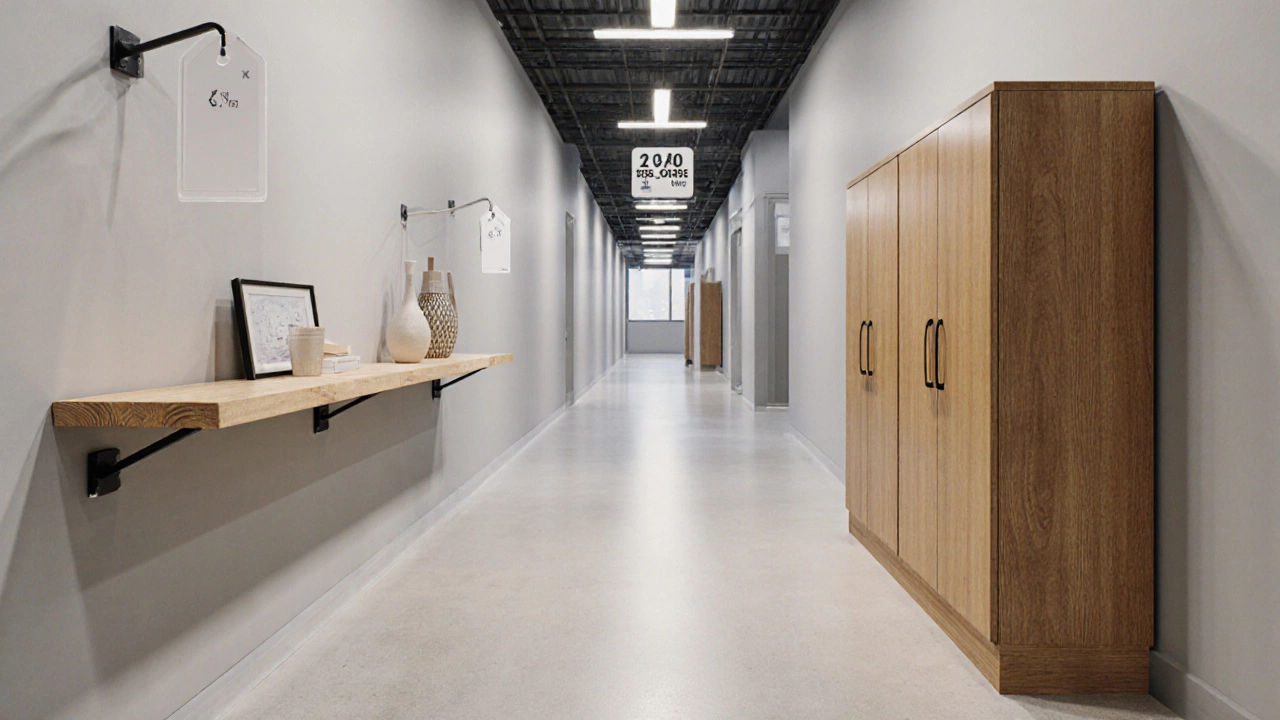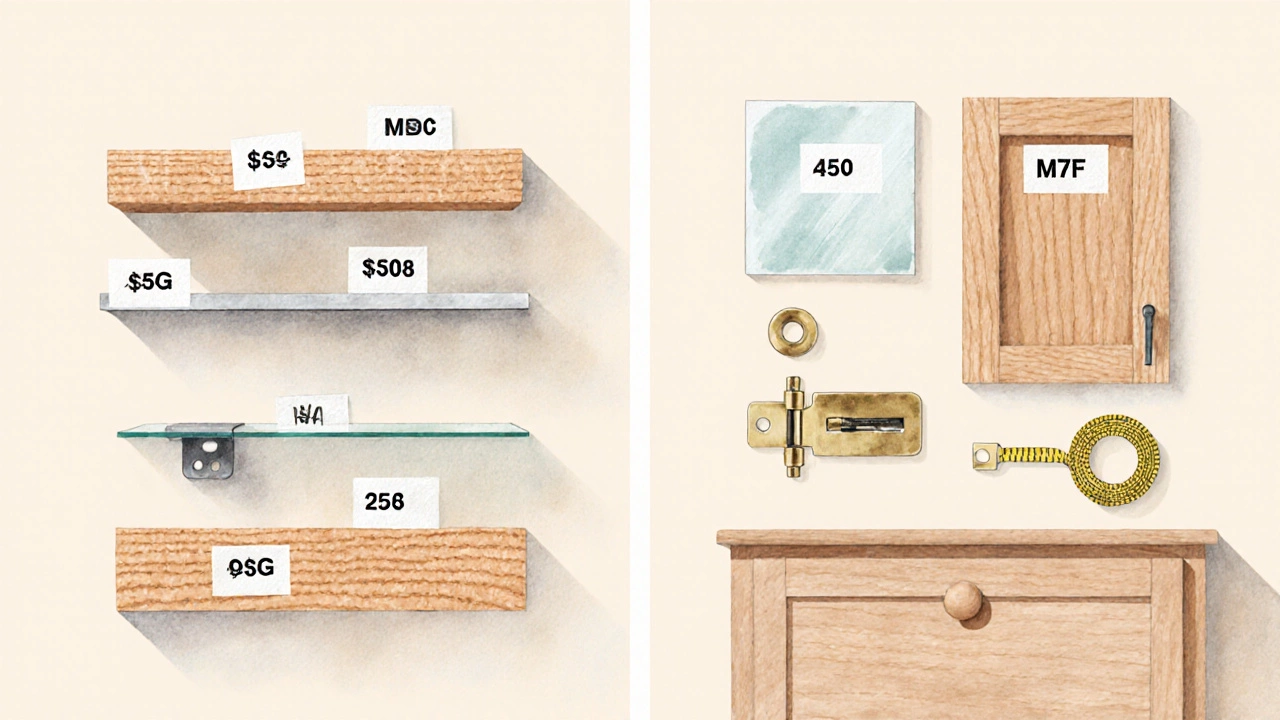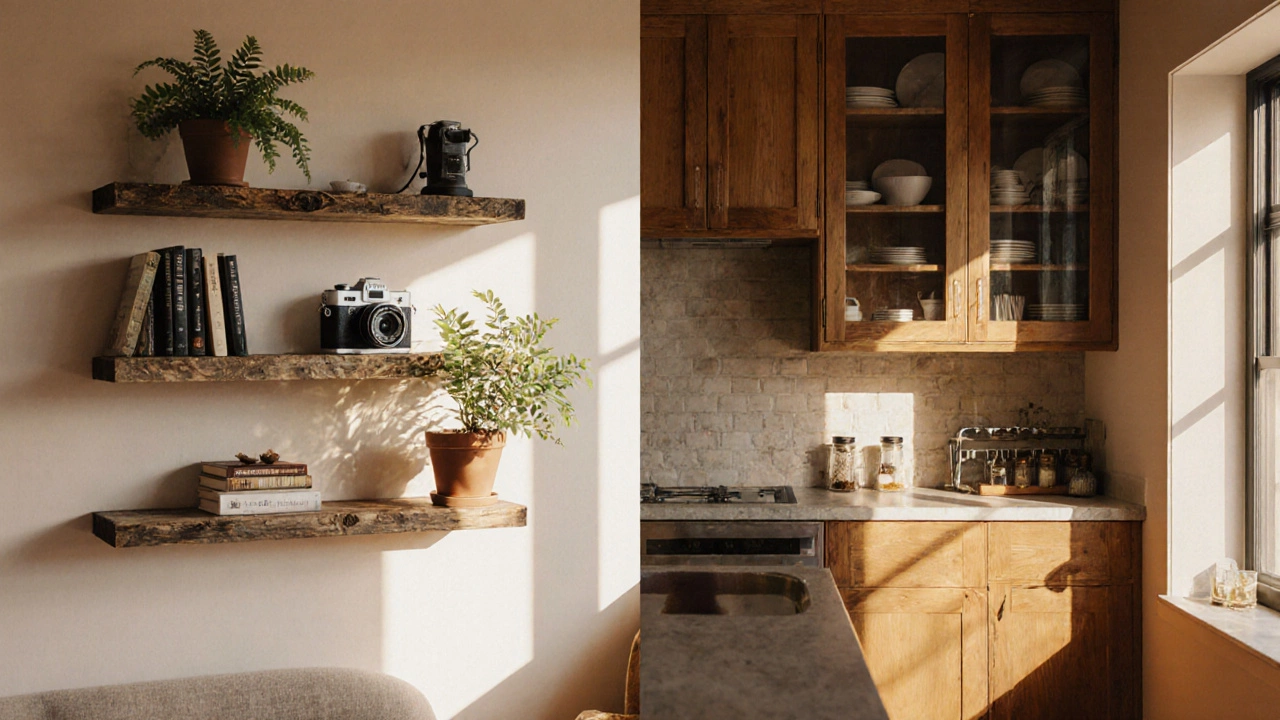Floating Shelves vs Cabinets: Which Is More Affordable?

Quick Takeaways
- Floating shelves typically cost 40‑70% less than standard cabinets when you factor in materials and installation.
- Cabinets offer higher load‑capacity and built‑in storage features, which can justify the higher price for kitchens and bathrooms.
- DIY installation can shave $150‑$300 off the total for floating shelves, while professional cabinet fitting usually adds $300‑$800.
- Material choice (MDF, solid wood, metal) drives the biggest price swing for both options.
- Consider long‑term durability, resale value, and the visual impact before deciding purely on price.
When you walk into a showroom and see a sleek floating shelf beside a sturdy cabinet, the first question that pops up is usually "floating shelves cost less than cabinets?" The answer isn’t a simple yes or no because price depends on many moving parts-materials, labour, installation method, and the purpose of the storage. This guide breaks down every cost factor, compares the two options side‑by‑side, and gives you a decision‑making framework so you can spend wisely.
What Drives the Price of a Storage Piece?
Before diving into numbers, it helps to understand where money goes. Both floating shelves and cabinets share three cost categories:
- Material - the raw component (wood, metal, glass, MDF) that determines base price.
- Hardware - brackets, hinges, pulls, and brackets for shelves; doors, shelves, and mounting hardware for cabinets.
- Installation labour - DIY effort versus professional fitting.
Other hidden costs include finishing (paint, stain), reinforcement for heavy loads, and future maintenance. By examining each category for both storage types, you can see why the headline price often tells only part of the story.
Floating Shelves: Cost Breakdown
Floating shelves are open, wall‑mounted platforms that create a light visual footprint. Because they lack doors or internal framing, the material price is generally lower.
Materials
- MDF - $15‑$25 per 2‑ft board, ideal for painted finishes.
- Solid pine or oak - $30‑$45 per 2‑ft board, gives a natural look and higher load capacity.
- Metal (steel or aluminum) - $25‑$40 per 2‑ft section, perfect for industrial style.
- Glass - $40‑$70 per panel, used for decorative accents.
Hardware
- Bracket kits (usually 2 per shelf) - $10‑$25 each, depending on finish and load rating.
- Wall anchors and screws - $5‑$15 per set, essential for plaster or concrete walls.
Installation
- DIY - Average time 30‑45 minutes per shelf; cost is essentially your time.
- Professional carpenter - $80‑$120 per hour; most charge a flat $150‑$250 for a set of 3‑4 shelves.
Putting it together, a typical 4‑shelf floating‑shelf unit (2ft each) made from pine and mid‑range brackets runs around $240‑$320 if you do it yourself, and $380‑$530 with a pro.
Cabinets: Cost Breakdown
Cabinets provide enclosed storage, often with adjustable interior shelves, doors, and built‑in hardware. That added functionality drives up both material and labour costs.
Materials
- Stock cabinets (pre‑finished MDF or particleboard) - $80‑$150 per linear foot.
- Semi‑custom (laminate veneer or painted wood) - $120‑$200 per linear foot.
- Custom solid‑wood cabinets - $250‑$400 per linear foot, plus finish.
Hardware
- Hinges, pulls, soft‑close mechanisms - $5‑$25 each, multiplied by the number of doors.
- Internal shelving, drawer slides - $10‑$30 per unit.
Installation
- DIY - Requires carpentry skills, level walls, and often plumbing/electrical coordination. Average time 4‑6hours for a 2‑door wall cabinet.
- Professional installer - $300‑$800 per cabinet run, depending on complexity, permits, and locale.
Example: A 6‑ft wall cabinet run in a kitchen using semi‑custom material costs roughly $900‑$1,200 for the cabinets themselves, plus $400‑$600 for professional fitting - total $1,300‑$1,800.

Side‑by‑Side Cost Comparison
| Item | Floating Shelves (4‑unit set) | Cabinets (6ft wall run) |
|---|---|---|
| Material | $120‑$180 | $800‑$2,400 |
| Hardware | $40‑$80 | $150‑$300 |
| Installation (DIY) | $0‑$50 (time only) | $200‑$500 (tools, extra labour) |
| Installation (Pro) | $150‑$250 | $300‑$800 |
| Total (DIY) | $160‑$310 | $1,150‑$3,200 |
| Total (Pro) | $310‑$430 | $1,500‑$3,600 |
The numbers show a clear price gap: floating shelves can be less than half the cost of a comparable cabinet run, especially when you tackle the installation yourself. But raw price isn’t the whole picture.
Hidden Costs and Long‑Term Considerations
Even if floating shelves look cheaper upfront, there are hidden factors that can affect the total cost of ownership.
- Load capacity - Typical floating shelves hold 15‑30lb per foot. Overloading can lead to wall damage, which incurs repair costs.
- Durability - MDF shelves may warp in humid climates (like Wellington’s damp winters), requiring replacement sooner than solid‑wood cabinets.
- Resale value - Kitchens with built‑in cabinets tend to boost property appraisal more than an open‑shelf aesthetic.
- Maintenance - Cabinets often need periodic hinge lubrication and door alignment checks, while shelves mainly need dusting.
- Future re‑configuration - Floating shelves are easy to move; cabinets are semi‑permanent, meaning you may pay for demolition if you change layout.
When Floating Shelves Win the Budget Battle
If your primary goal is visual lightness, quick installation, and a modest price tag, floating shelves are hard to beat. Ideal scenarios include:
- Living‑room display of books, plants, or décor where open access is desired.
- Renters who need a non‑permanent solution - brackets can be removed without major wall repair.
- Odd‑shaped wall niches where custom cabinets would waste material.
- Home offices that need occasional extra surface area without committing to a full cabinet.
In these cases, a DIY approach can keep the total spend under $250 for a stylish, functional set.

When Cabinets Are Worth the Extra Spend
Cabinets shine when you need robust storage, moisture‑resistance, or an integrated look. Consider cabinets if you:
- Design a kitchen, bathroom, or utility room where water splashes, heavy cookware, or cleaning supplies are common.
- Require internal organization - pull‑out drawers, built‑in dividers, or lazy‑Susan mechanisms.
- Value long‑term durability - solid‑wood or high‑quality laminate cabinets can last decades.
- Want to boost home resale - a well‑designed cabinet line often adds $5,000‑$10,000 to property value.
Even though the upfront cost is higher, the functional payoff can outweigh the price gap over time.
How to Choose the Right Solution for Your Space
Use this quick decision checklist to avoid buyer’s remorse:
- Define the load. If you’ll place more than 30lb per foot, lean toward cabinets or reinforce shelves with steel brackets.
- Assess the wall. Solid plaster or concrete can handle heavy brackets; drywall may need anchors that add cost.
- Set a budget ceiling. Include material, hardware, and installation (DIY or pro) in the total.
- Consider permanence. Renting? Choose floating shelves you can remove. Owning? Cabinets may add value.
- Think about aesthetics. Open shelving creates a modern, airy feel; cabinets give a polished, built‑in look.
After you answer these questions, compare the numbers from the table above with your personal priorities. If the total for floating shelves fits comfortably under your budget while meeting load and style needs, go for them. If you need heavier duty storage and are okay with a higher spend, cabinets are the smarter long‑term play.
Frequently Asked Questions
Are floating shelves cheaper than cabinets for a small bedroom?
Yes, on average a set of four floating shelves costs $160‑$310 installed DIY, while a modest 4‑ft wall cabinet run ranges from $1,150‑$3,200 installed. The price gap widens if you hire professionals for installation.
Can I install floating shelves myself without damaging the wall?
Absolutely, as long as you use the right anchors for your wall type. For plaster or concrete, toggle bolts or masonry anchors are ideal. For drywall, a stud‑finder and 2‑inch wood screws work well. The process usually takes 30‑45 minutes per shelf.
Do cabinets increase my home’s resale value?
Professional appraisers often assign a higher value to homes with built‑in kitchen or bathroom cabinets. Depending on the quality, you could see a $5,000‑$10,000 boost in appraisal.
What’s the strongest material for floating shelves?
Solid hardwoods like oak or maple, paired with steel brackets rated for 50‑70lb per foot, provide the highest load capacity while still looking sleek.
Is it worth spending more on custom cabinets?
If you want a perfect fit, premium hardware, and a design that matches your home’s style, custom cabinets can be worth the extra $250‑$400 per linear foot. For standard layouts, semi‑custom or stock options usually deliver good value.
Bottom line: floating shelves win on pure price, especially when you DIY, but cabinets bring sturdier storage, higher resale impact, and a cohesive look for high‑traffic rooms. Use the cost table, hidden‑cost checklist, and FAQ as a toolbox to make a choice that fits your wallet and lifestyle.